- About us»
- Net income calculator»
- Population aging»
-
- Least developed regions»
-
- Average wage
- Material need benefits
- Meal allowance
- Counties of Slovakia
- Inflation
- Living and Subsistence Minimum
- Unemployment of Czechia and Slovakia
- NACE Classification
-
- Life expectancy
- Gender differences
- Youth unemployment and NEET
- Minimum wage in EU
- Unemployment rates of different age groups
- Share of salaries on GDP
- Employment rate
- Percentage of employees ususally working at nights
- NEET
- Long term unemployment
- Unemployment rate
-
- Bratislava and surroundings
- Kopanice
- Danube river
- lower Vah river
- middle Vár river
- upper Nitra river
- lower Nitra river
- Mining cities
- Kysuce a Orava
- upper Vah river - Liptov
- Spiš cities
- upper Hron river
- Juhoslovenská kotlina
- Košice fold and Torysa river
- upper Zemplín
- lower Zemplín
- EU regions
- NUTS3 regions of Slovakia
- LAU1 dataset
-
- Projects and activities
- Inclusive growth»
- Good work
- Project SKRS
- Social system – reality and vision
-
- Education of unemployed
- Young unemployed not taking part in education
- Proposal to change the system of education funding
- Library
- News»
- Contact
Continental Portugal – PT1
EU regions: Portugal > Continental Portugal
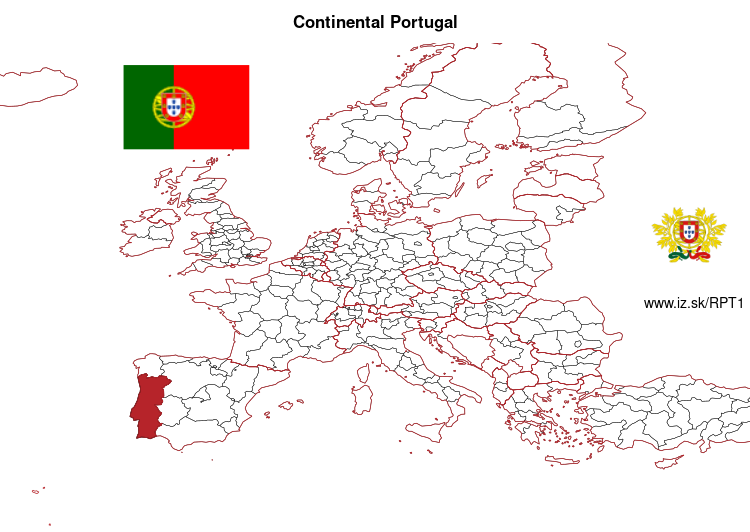
| Indicator | Period | Value |
|---|---|---|
| Life long learning | ||
| life long learning participation | 2024 | 16.4 |
| Part time jobs and flexible employment | ||
| percentage of part time workers | 2024 | 7.59 |
| percentage of part time workers, men | 2024 | 5.32 |
| percentage of part time workers, women | 2024 | 9.9 |
| Gender differences | ||
| gender gap in employment rate | 2024 | 93.38 |
| gender gap in unemployment rate | 2024 | 113.11 |
| Graduates and young people | ||
| unemployment rate of youth with elementary education | 2024 | 36 |
| NEET | 2024 | 7.6 |
| Gross domestic product | ||
| GDP per capita in PPS of EU average | 2023 | 81 |
| Employment | ||
| employment rate | 2024 | 72.9 |
More on wikipedia wikidata Q2915956 on OpenStreetMap Continental Portugal slovensky: PT1
Subregions: Norte Region, Algarve, Centro region, Lisbon Region, Alentejo region
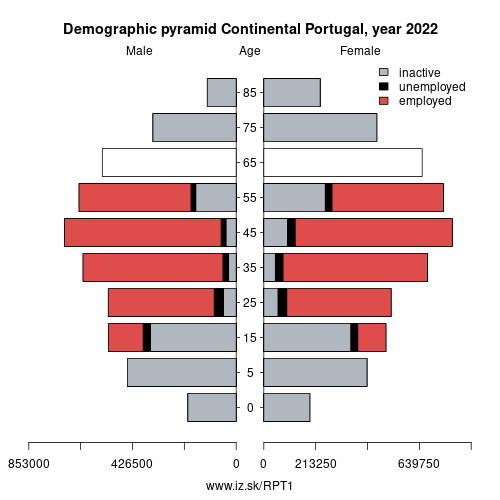
Unemployment
| Indicator | Period | Value |
|---|---|---|
| Unemployment | ||
| unemployment rate | 2024 | 6.7 |
| youth unemployment rate | 2024 | 21.9 |
| Long term unemployment | ||
| long term unemployment | 2024 | 2.4 |
| share of long term unemployed | 2024 | 36.7 |
Demographics
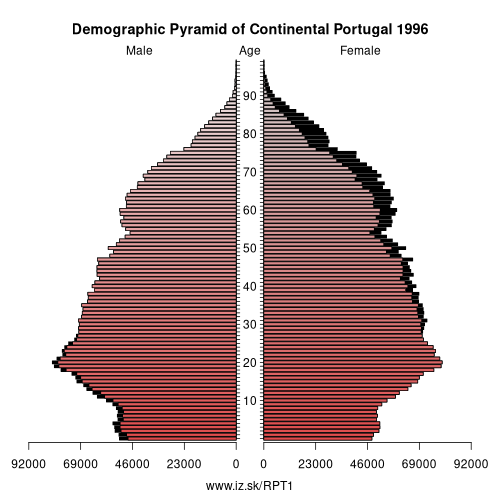
| Indicator | Period | Value |
|---|---|---|
| Demographics | ||
| number of inhabitants | 2024 | 10 142 079 |
| population density | 2023 | 114.7 |
| old-age dependency ratio | 2024 | 38.7 |
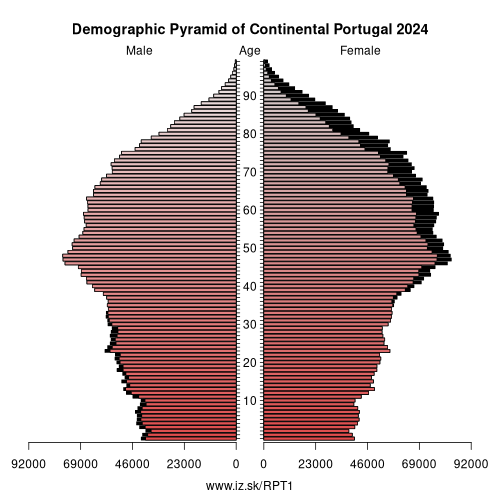
Employment by sectors, Continental Portugal
| NACE r2 | % | NACE r2 | % | ||
|---|---|---|---|---|---|
| A | 134.7 | 3% | B-E | 888.9 | 18% |
| F | 337.5 | 7% | G-I | 1232.9 | 25% |
| J | 201.1 | 4% | K | 107.5 | 2% |
| L | 53.2 | 1% | M_N | 430.8 | 9% |
| O-Q | 1185.9 | 24% | R-U | 295.2 | 6% |
| TOTAL | 4867.7 | 100% |
Data for the period year 2024. Source of the data is Eurostat, table [lfst_r_lfe2en2].
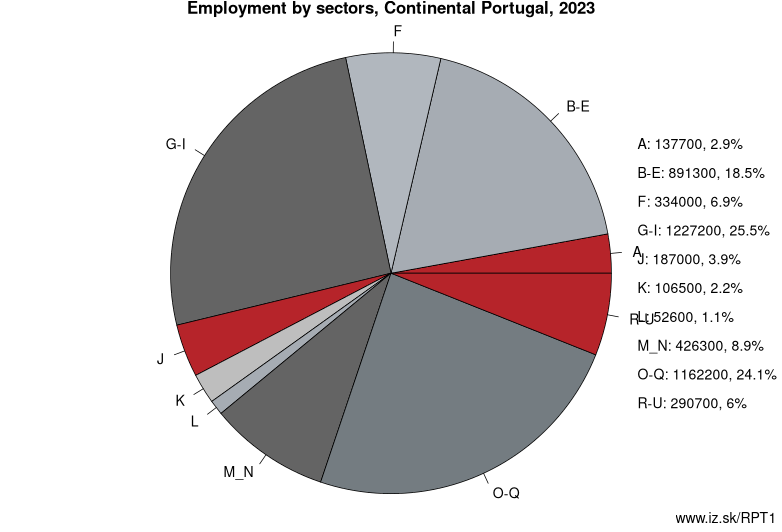
Portugal (Portuguese: [puɾtuˈɣal]), officially the Portuguese Republic (Portuguese: República Portuguesa [ʁɛˈpuβlikɐ puɾtuˈɣezɐ]), is a country located mostly on the Iberian Peninsula in southwestern Europe. It is the westernmost sovereign state of mainland Europe, being bordered to the west and south by the Atlantic Ocean and to the north and east by Spain. Its territory also includes the Atlantic archipelagos of the Azores and Madeira, both autonomous regions with their own regional governments.
Portugal is the oldest nation state on the Iberian Peninsula and one of the oldest in Europe, its territory having been continuously settled, invaded and fought over since prehistoric times. The pre-Celtic people, Celts, Carthaginians and Romans were followed by the invasions of the Visigoths and Suebi Germanic peoples. Portugal as a country was established during the Christian Reconquista against the Moors who had invaded the Iberian Peninsula in 711 AD. Founded in 868, the County of Portugal gained prominence after the Battle of São Mamede in 1128. The Kingdom of Portugal was later proclaimed following the Battle of Ourique in 1139, and independence from León was recognised by the Treaty of Zamora in 1143.
In the 15th and 16th centuries, Portugal established the first global empire, becoming one of the world's major economic, political and military powers. During this period, today referred to as the Age of Discovery, Portuguese explorers pioneered maritime exploration, notably under royal patronage of Prince Henry the Navigator and King John II, with such notable voyages as Bartolomeu Dias' sailing beyond the Cape of Good Hope (1488), Vasco da Gama's discovery of the sea route to India (1497–98) and the European discovery of Brazil (1500). During this time Portugal monopolized the spice trade, divided the world into hemispheres of dominion with Castille, and the empire expanded with military campaigns in Asia. However, events such as the 1755 Lisbon earthquake, the country's occupation during the Napoleonic Wars, the independence of Brazil (1822), and a late industrialization compared to other European powers, erased to a great extent Portugal's prior opulence.
After the 1910 revolution deposed the monarchy, the democratic but unstable Portuguese First Republic was established, later being superseded by the Estado Novo right-wing authoritarian regime.
Other: Portugal, Madeira (NUTS 1), Azores (NUTS 1), Continental Portugal
Neighbours: Sur, Centro, Noroeste
Subregions: Norte Region, Algarve, Centro region, Lisbon Region, Alentejo region
Suggested citation: Michal Páleník: Europe and its regions in numbers - Continental Portugal – PT1, IZ Bratislava, retrieved from: https://www.iz.sk/PPT1, ISBN: 978-80-970204-9-1, DOI:10.5281/zenodo.10200164

 Share
Share Facebook
Facebook Twitter
Twitter News
News